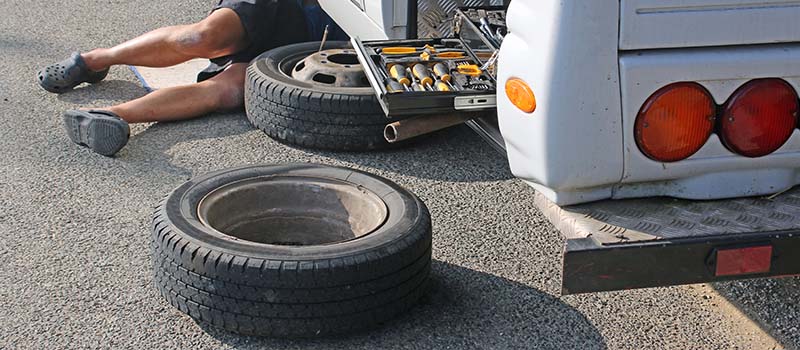Prevent Blowouts With RV Tire Maintenance
Prevent Blowouts With RV Tire Maintenance

Prevent Blowouts With RV Tire Maintenance
- Check for proper tire inflation. Look on the driver’s side door for a sticker that contains information on tire size and PSI (pounds per square inch). Be sure that the tires installed meet these requirements, and check your tire pressure to make sure they are inflated to the suggested PSI. Severely overinflated or underinflated tires can put you at higher risk for a blowout.
- Check your information on tire purchase history. With normal wear, RV tires need to be replaced approximately every five years. Keeping good records of your tire purchases can be a helpful reference point for when to replace your tires.
- Inspect your tire tread. Minimum recommended tread length varies by tire, so you’ll want to check the manufacturer’s website for specifics. As a general rule, you can inspect your tread by using a quarter and placing it in the valley of several treads of each tire (once it has cooled). The tread should cover part of Washington’s head on the quarter, if the tire’s tread is still intact.
- Inspect your tires’ sidewalls for cracks. This is especially important to consider if you store your RV in the outdoors during the cold winter months. Look closely for cracks, bumps or fissures, and get your tires services or replaced if you see any present.
- Make sure to rotate and balance your tires on a regular basis. In most cases, you’ll need to have your rear tires rotated to the front, in order to prevent uneven wear. You’ll also want to have your tires balanced regularly to make sure certain tires don’t wear out quicker than others.
- Consider your RV’s load rating and weight limit. Along with the recommended tire PSI, the yellow sticker located on the driver’s side door also includes information about weight limits. Check on these limits when you’re planning an extended trip, especially if you’re planning to carry a lot of heavy gear or supplies on board your RV.
- Balance your load across all of your RV’s axles. In case you are hauling heavy equipment or supplies, be sure to balance the weight across the axles as carefully as possible. Too much weight toward one side, the front or back of the RV can put additional pressure on those tires, increasing your risk of a blowout.
- In the event of a blowout, react quickly and calmly. Even though a blowout can be scary, try not to overreact. Keep your hands on the steering wheel and keep steering straight, as the vehicle may lurch toward the direction of the blown out tire. Do not slam on your brakes, and check your mirrors to see if it is safe to pull off of the road. Turn on your flashers and calmly pull over to the shoulder.
- Check to see if you have roadside assistance coverage. Some policies include limited coverage to help you in the event of a blowout or breakdown, and in most cases, you can purchase additional coverage to include these services.
If you’re uncertain about what coverage you currently have, or want to purchase additional coverage in advance of your next big trip, be sure to reach out to your local agent. They will work with you to help you get the right coverage for the right price, no matter where you’re planning to travel!
